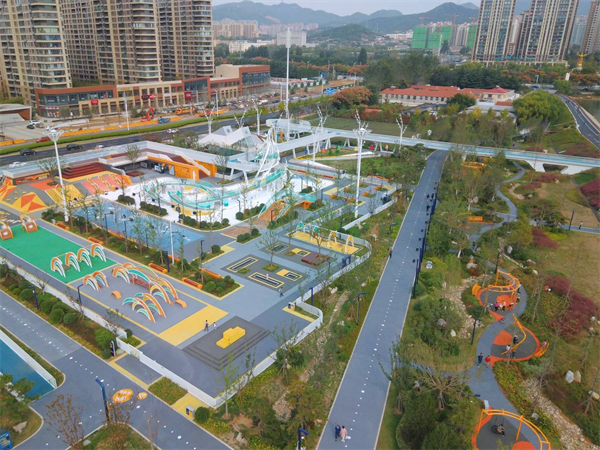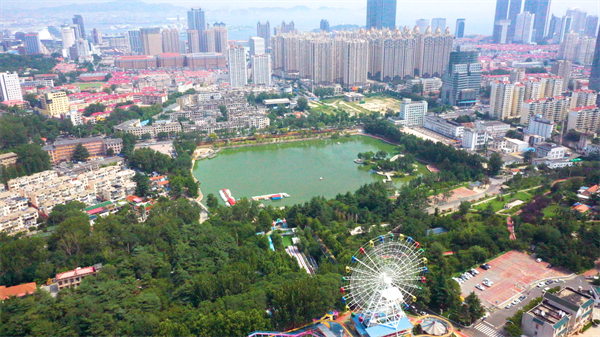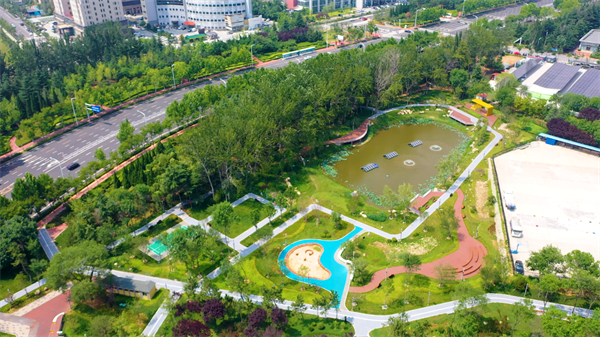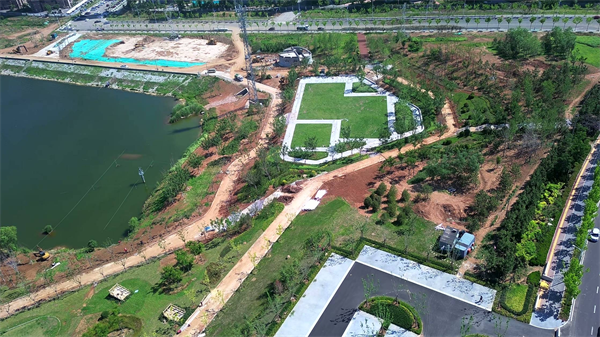From “Dormant?Depressions” to “Civic Parks”: What Has Yantai Awakened?
Aristotle once said, “Men come together in cities to live, but they remain together to live the good life.” This quote resonates with heightened practical relevance when viewed through the lens of modern Yantai.
Let’s turn our attention to these subtle scenes from daily life right before us:
Once-polluted and neglected lake areas have been restored and transformed into comprehensive parks integrating ecology, culture, leisure, and smart services. “Dormant ponds” scattered among office buildings have been awakened into vibrant spaces friendly to all age groups. Enclosing fences and barriers separating lake areas in parks from urban blocks have been dismantled, making greenery visible and accessible at every turn.
These concrete, lively scenarios illustrate a crucial shift in urban development: in its ongoing pursuit of building a livable, resilient, and smart city, Yantai has taken the renovation of reservoirs and ponds as a brush to build an ecologically resilient city, truly transforming urban construction into high-quality living spaces.
Today in Yantai, numerous “water-rich” spaces, blending ecological vitality, cultural connotations, and leisure functions, are bringing residents a greater sense of fulfilment while nurturing the vigorous growth of the city, like roots sustaining a tree.
01 Metamorphosis Through “Micro-Renewal”
Yantai is a typical resource-constrained water-scarce city, and its 149 reservoirs and ponds scattered across urban areas are particularly “precious.” How can innovative concepts and mechanisms drive the coexistence of economic, ecological, and humanistic values through the renovation of existing water bodies?
Two cases may offer answers from different perspectives:
— Phoenix Lake: From “Urban Scar” to Comprehensive Vitality Park in the Core Area.

As a rare ecological resource integrating “mountains and water” in the central urban area, Phoenix Lake in Laishan District should have been a scenic spot. Yet, due to dirty and messy surroundings, it had long been considered an “urban scar.”
In September 2022, Laishan District incorporated the Phoenix Lake area into its urban renewal plan and launched renovations. In just ten months, it was transformed into a comprehensive urban park featuring children’s entertainment, active sports, elderly leisure, and all-age sports services, attracting over 10,000 daily visitors and hosting multiple international events.
Strolling through Phoenix Lake, one finds former rubble heaps turned into tennis courts, garbage recycling stations converted into aerial corridors, and abandoned orchards transformed into children’s playgrounds. The 1,700-meter smart trail around the lake, equipped with intelligent facilities such as projectors and telescopes, has replaced the former dirt path.
Wherever there is clear water and green shores, there are annotations of quality of life. The renovated Phoenix Lake Park has completed a “triple jump” from ecological restoration to functional reconstruction and cultural tourism empowerment, emerging as Yantai’s new internet-famous landmark.
— Nanshan Park: From “Wall Removal for Green Exposure” to Immersive Boundaryless Park

Known as “Central Park” by Yantai residents, Nanshan Park carries the memories of generations. Its artificial lake stands as one of the few “urban green lungs” and “picturesque paradise” in the central urban area. Unfortunately, due to barriers like railings and bushes along the north Huanshan Road, citizens and tourists couldn’t enjoy the beautiful scenery inside the park from the roadside.
The ongoing renovation of the north side of Nanshan Park’s artificial lake will completely break this “segregation”: removing physical barriers such as billboards and bushes, opening 7 new entrances, adding multiple viewing platforms, and realizing the vision of “the road merging into scenery and a single step into the park,” thus setting an example of simultaneous renewal for boundaryless parks and ecological adaptability.
Currently, other water spaces like the south pond of the Radio and Television Building and the Youth Park Pond have also been transformed into exquisite “parks at the doorstep.” By the end of July, renovation and upgrading projects for 6 sites, including the east pond of Shijia Lingxiu Community in Zhifu District and Wanghaiyuan Pond in Laishan District, will all start construction.
Whether through ecological restoration or bridging together fragmented spaces, these efforts embody Yantai’s innovative “one pond, one strategy” model for systematically renovating urban reservoirs and ponds and building a sponge city. According to a previously released action plan, Yantai prioritizes the renovation of water bodies that are of public concern, in urgent need of improvement, and capable of delivering tangible benefits, setting examples for future projects.
From “dormant depressions” to civic parks, from mere “ecological green spaces” to multi-functional “living rooms”—Yantai has achieved a leap in spatial value through refined urban operations, demonstrating urban wisdom.
02 Activating Urban “Catalyst Points”
Against the broader backdrop, interactions between urban development and ecological elements have never been as close as they are today. The accessibility of green spaces has become a key benchmark for measuring urban livability.
In fact, a scientifically sound ecosystem has always been a crucial factor in shaping urban form and improving the quality of life, with long-term benefits. Yantai’s development practices have clearly endowed the renovation of reservoirs and ponds with a deeper logic:
Breaking away from traditional greening thinking, the “ecology+” model promotes the functional integration of water environment spaces. This approach not only restores ecological base but also incorporates recreational functions; it preserves natural wildness and integrates smart elements, turning every water body into a “catalyst point” for activating urban vitality.

If we focus the lens on several water spaces, “poetic life” takes on a tangible form: around the south pond of the Radio and Television Building, accessible green spaces are set up, allowing citizens to wander freely; the Youth Park Pond features a colorful permeable walking trail, attracting over 3,000 visitors daily; the north side of Tianhecheng Pond has added water-friendly boardwalks and platforms, creating an ecological waterfront; Phoenix Lake Park hosted two international events, drawing over 10,000 on-site spectators and millions of online views.
These seemingly “micro-renewal” water spaces have quietly woven an ecological network covering the urban area, reshaping the fabric of citizens’ daily lives. The figures doing morning exercises amid the green shade by the pond at dawn, the bustling crowds on the park’s colorful trails in the evening, or parent-child explorations in the rain garden on weekends—all these are the “green well-being?” provided by the city, tangible, accessible, enjoyable, and comfortable.
What is even more commendable is that, given its natural conditions with low mountains and hills, and relatively scarce water resources, Yantai has avoided pursuing large-scale “green landscaping.” Instead, it has precisely integrated multiple functions, such as ecological restoration, rainwater management, and leisure activities, into limited water environment spaces, effectively revitalizing urban “leftover” spaces and creating a high-quality foundation for gathering urban popularity and boosting commercial vitality.

“We must uphold the philosophy of ‘micro-renovation, refined enhancement,’ promote the organic coexistence of ecological spaces with cultural experiences and urban functions, and create urban spaces where citizens and tourists can enjoy mountains and water.” This philosophy advocates a gradual, refined development path, emphasizing the deep integration of ecological foundations, cultural spirit, and urban vitality. It focuses on in-depth exploration and optimal utilization of existing resources, enhancing urban quality with “embroidery-like” meticulousness.
Each of these “catalyst points” activating urban arteries reflects, in a subtle way, how this mountain-and-sea city responds to the propositions of the times.
03 Returning Focus to People Themselves
The recently concluded Central Urban Work Conference once again emphasized “transforming urban development philosophy” and “placing greater emphasis on people-centered development.” A thought-provoking question remains: How can the philosophy of “people-centered city” be deeply embedded in urban governance, turning development investments truly into people’s well-being?
The significance of Yantai’s cases may lie in its emphasis on placing the value of “people” at the origin of urban planning and construction.
Cities belong to people, and “people” should be the core measure of urban development. When urban development returns to a people-centered logic, lakes, ponds, and reservoirs are built for people—they are not merely ecological spaces but also “living rooms” for high-quality urban life. These “urban living rooms” are easily accessible near homes and office buildings, undoubtedly making Yantai a more relaxed and happier city with a stronger appeal.

“The environment is great, facilities are complete, and both the elderly and children can find something to enjoy here,” said Han Yuqi, a resident of Fenghuang Shanzhuang Community, who visits Phoenix Lake Park with her child every evening after dinner.
“After lunch, walking and chatting by the pond with colleagues makes me feel much more relaxed,” said Yu Qingyuan, who works at Changdao Ocean Building.
“Now we can see the beauty of Nanshan Park from Huanshan Road and enter the artificial lake directly. The park has become more convenient and people-friendly,” noted Sun Wei, a resident of Zhifu District. “Every subtle change in the city keeps raising our happiness index.”
When people of different ages, professions, and interests coexist harmoniously here, public spaces truly become a natural extension of citizens’ lives. The ultimate significance of renovation is not to create uniform landscapes but to become the “soil” that nurtures urban life. The true charm of urban spaces may lie in this: they are public, yet they can belong to each and every individual.
“With the goal of building an innovative, livable, beautiful, resilient, civilized, and smart modern city for the people,” the initiative will “make cities healthier, safer, and more livable as spaces for people to enjoy high-quality lives.” The “rebirth” of Yantai’s reservoirs and ponds acts like a mirror, reflecting a pragmatic approach to putting the “people-centered city” philosophy. It contains both the grand narrative of green and low-carbon development and meticulous care for people’s livelihoods. When everyone can encounter greenery around the corner and feel warmth in spatial interactions, the city truly becomes the living place we yearn for.
In this way, the city’s growth vitality becomes more dynamic, rooted, vibrant and sustainable.
YMG All-Media Reporters: Gao Wei, Liu Jie
Photographers: Tang Ke, Wang Yiming

